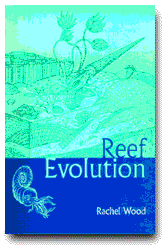Reef Evolution
by Rachel Wood
Oxford University Press, 1999, 414 p.
ISBN 0-19-854999-7, $100.00 U.S.

Reef Evolutionby Rachel Wood |
 |
![]()
The study of reefs is full of paradoxes. Although robust in species numbers, modern coral reefs are surprisingly delicate ecosystems dependent on clear, clean, warm water. Modern reefs live in an nutrient desert yet have the highest rates of net primary production when compared to other marine communities. The evolutionary innovations that are used to define modern reefs are relatively recent geologically. For example, scleractinian corals acquired photosymbionts in the Late Triassic. And the reef fish fauna, deemed critical to remove fleshy green algae that choke reefs, are relative latecomers arriving in the Eocene. The chasm between those who study ancient reefs and modern reefs is distressingly large (e.g. what a geologist might call a reef in the Cambrian bears little resemblance to what a biologist calls a reef today).
In Reef Evolution, Rachel Wood takes on the task of answering these seeming paradoxes from a "biological perspective" without jargon. When the woman who turned the Capitan Reef upside-down writes a book about reef evolution, you might expect another iconoclastic view. Instead, you find is a meticulously researched book written by a paleontologist with a strong geology background. While Wood claims that it is not her role to detail fossil communities, this is the books strongest chapter. If Fagerstrom's The Evolution of Reef Communities, is currently on your book shelf, don't throw it out; but do check in Reef Evolution for the most recent interpretations. Excellent, thoughtful illustrations are the centerpieces of the ancient reef case studies. The reef might appear in outcrop while simultaneously presenting the real community view. A biologist reading this chapter might be intimidated since Wood blithely uses phrases such as the southern Tethyan shore during the earliest Jurassic without a paleogeographic reconstruction to help aid the reader. But a student of geology will not find these descriptions inaccessible.
Wood's most original discussion comes at the middle of the book, on "The role of mass extinctions" in reef evolution and "The rise of biological disturbances." Here she weaves in some original ideas about global biogeochemical processes that may have affected carbonate platform development, species interactions, evolutionary innovations and thereby reef evolution. For example, Wood offers that some sessile reef organisms (e.g. corals and coralline algae) appear to not only to thrive but actually require conditions of heavy grazing for their survival in shallow tropical seas. Wood's writing style is not always easily digestible. Some very important sentences, particularly in this chapter, require review.
Another novel chapter ("Life on a substrate: trends in form and function") briefly traces the morphological trends amongst colonial organisms in shallow carbonate settings. Traits acquired polyphyletically over a very short space of geological time is are compelling evidence for the operation of an extrinsic selective force. From that statement, Wood launches into several examples from Paleozoic to modern trends in reef morphologies. Yet this chapter ignores similar morphological trends in other solitary or pseudo-colonial groups which Wood discussed in the chapter on ancient reef ecologies. Archaeocyathids, a pet group of the author, receive center stage disproportionately.
Meticulously researched, the book offers the latest references for the geological chapters but not in the more biologically-oriented chapters. These chapters unfortunately do not represent cutting-edge research. This disparity may be a statement about the current trend in the reef biological research from an ecological or community focus to a species-level or genetic focus. Yet there are a series of recent papers published from the shallow water chemistry community that may have been more appropriate in the chapter on the role of physicochemical change. This book fills a valuable role as a primer for the reef biologist who wants to expand his or view of the reef community into geological time. For the geologically-trained paleontologist, it serves as an excellent reference to arguably the most dynamic marine ecosystem.
Copyright:
Coquina Press
15 November 2000
http://palaeo-electronica.org